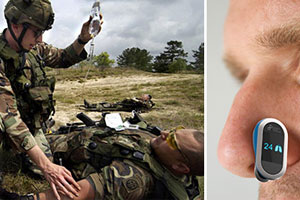Innovative technology and design consultancy Cambridge Design Partnership has developed the world’s first wearable device designed to measure and monitor the vital signs of multiple trauma patients for emergency response in disasters and battlefield situations.
The First Response Monitor is designed to help medics monitor both heart rate and respiratory rate. Respiratory rate is often neglected by automated monitoring systems and has been described as the ‘forgotten bio-sign’, as many existing wearable monitors focus on heart rate alone and those that do measure respiratory rate have low accuracy or are difficult to use in an emergency situation. However, the benefits of accurately monitoring respiratory rate are clear, and when combined with other parameters – such as heart rate and body temperature – can indicate life-threatening conditions such as sepsis.
When designing the new compact device, Cambridge Design Partnership interviewed a range of army medics about their needs and challenges in multiple casualty emergency situations. An unmet need was identified for a low-cost device to bridge the gap between manual methods of vital signs measurement – which can be laborious and challenging amidst the noise and stress of a disaster or on the front line – and more expensive patient monitoring systems.
The lightweight, robust and low-cost wearable biometric device not only monitors patients but collects and transmits data in real-time, enabling the medic to care for a greater number of casualties, providing more effective casualty triage to deliver improved patient outcomes.
The small device clips onto a patient’s nose and monitors breathing rate and heart rate, giving ‘at a glance’ indication of both parameters, and this data is added to a trends graph showing how these measurements have changed over time. This enables the medic to focus their efforts on providing care rather than taking measurements but also enables the care giver to understand how the patient’s condition has changed over time. The data can then transmitted using Bluetooth low energy to a smartphone app or tablet, enabling other data analyses such as multiple patient triage or situational awareness across the group.
Although the device has been primarily designed with first response medics in mass casualty incidents in mind, it has applications in many other fields – such as civilian medicine where additional monitoring of conditions has demonstrable benefit in patient outcomes, wellness monitoring and within sports for training and performance monitoring. The technology can also be developed to provide a low-cost solution for low resource healthcare settings.
Speaking about the new development partner, James Baker said: “At Cambridge Design Partnership we’re always looking for ways to find a solution to a clear, unmet need. With the First Response Monitor we’ve combined our expertise in wearable connected devices with our extensive medical experience to develop a technology for effectively measuring breathing and heart rate. The monitor can help save lives in a variety of environments and we’re really keen to speak to partners about developing the potential applications further.”
Also see: Elecsys wins remote monitoring order from US military










